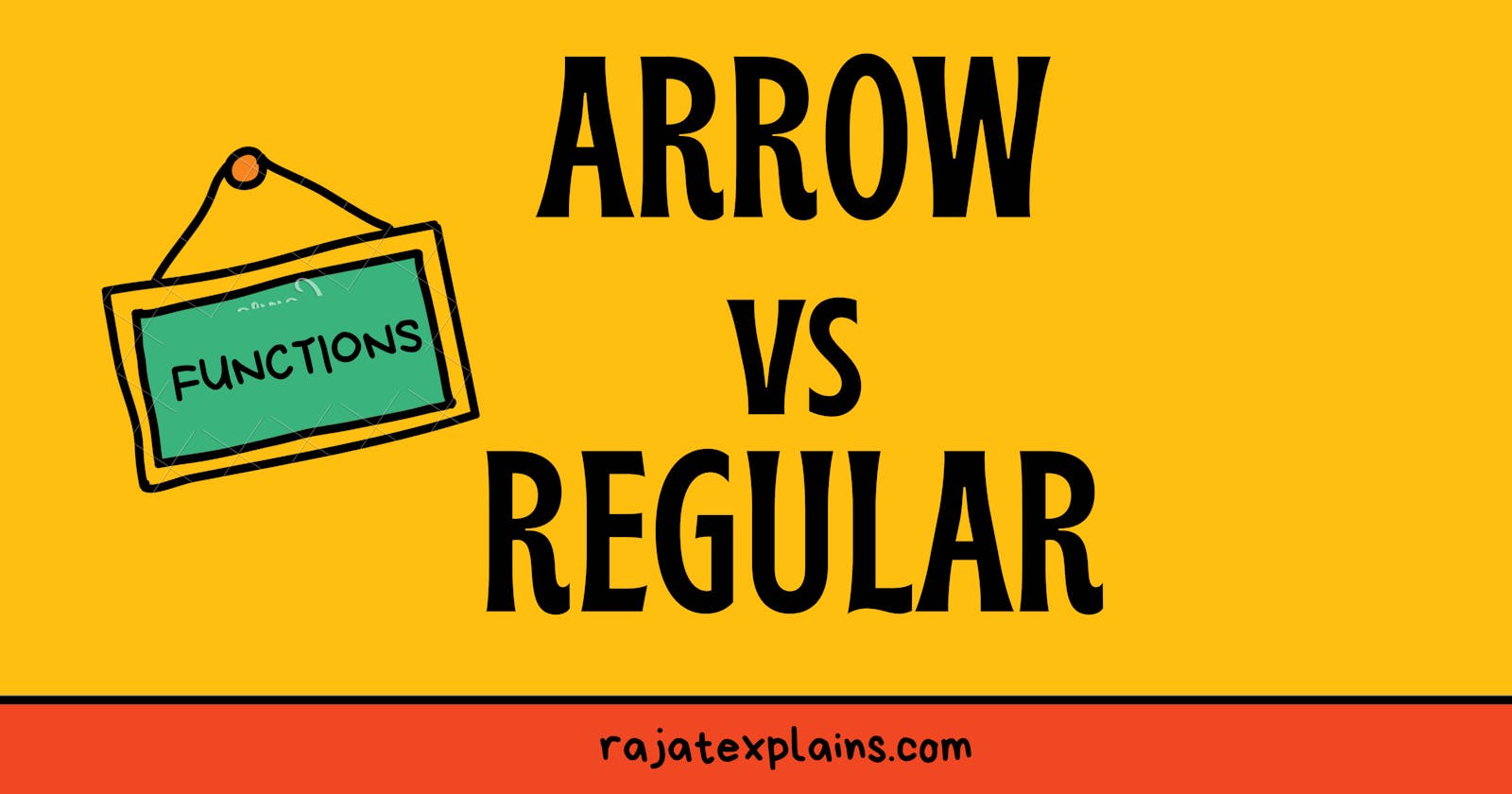If you like to listen 🎧 to this article as a natural sounding 🔈 audio experience:
Most of us know that the usual way of declaring/defining functions in most languages is a simple regular syntax. In Javascript too, for a long time you could declare functions only using this syntax
// Function Declaration
function goodOlDays(whatever) {
console.log(`Hello ${ whatever }`)
}
// Function Expression
const goodOldDays = function(whatever) {
console.log(`Hello ${ whatever }`)
}
I will call the above declared or expressed function as the regular function.
Then, with ES6 (ES2015), there came a new unusual syntax, something of a sort that was quite unseen in any other language and was aesthetically cooler.
// Arrow function syntax
const newerSyntax = (whatever) => {
console.log(`Hello ${ whatever }`)
}
This did not mean that the old syntax was not allowed or valid anymore. Actually, there are times when using the regular syntax actually is the easier/right path. While both the syntaxes define functions, when would you choose one over another? That’s a good question.
In this post, I’ll show the main differences between the two, so you could choose the right syntax as per your needs.
1. The this value
To understand in depth how this works in JS, I have a nice descriptive article.
 You can check it out.
You can check it out.
a). Regular functions
In regular functions, the this value (aka execution context) is dynamic, i.e., its value depends on how the function is invoked. In Javascript, there are four ways in which a function can be invoked.
👉 Simple invocation
During a simple invocation the value of this equals to the global object (or undefined if the function runs in strict mode):
function doSomething() {
console.log(this)
}
// Simple invocation
doSomething(); // logs global object (window)
👉 Method invocation
A method, like a function, is a set of instructions that performs a task. The difference is that a method is associated with an object, while a function is not.
In method invocation, the value of this is the object owning the method
const myObj = {
doSomething() {
console.log(this)
}
}
//Method invocation
myObj.doSomething() // logs myObj
👉 Indirect invocation
In this, the function is invoked using the call or apply method and the value of this is passed explicitly and is equal to the first argument
function doSomething() {
console.log(this);
}
const context = { value: 'A' };
doSomething.call(context); // logs { value: 'A' }
doSomething.apply(context); // logs { value: 'A' }
👉 Constructor invocation
During a constructor invocation using new keyword, this is equal to the newly created instance:
function DoSomething() {
console.log(this);
}
new DoSomething(); // logs an instance of DoSomething
b). Arrow Functions
The behavior of this inside of an arrow function differs considerably from the regular function’s this behavior. The arrow function doesn’t define its own execution context.
No matter how or where being executed, this value inside of an arrow function always equals this value from the outer function. In other words, the arrow function resolves this lexically.
const doSomething = {
myMethod() {
console.log(this); // logs myObject
const callback = () => {
console.log(this); // logs myObject
};
callback();
}
};
doSomething.myMethod();
Here, callback does not have its own this. It "looks up" (resolves lexically) in its outer context and assumes the value of this from there.
this resolved lexically is one of the great features of arrow functions.
When using callbacks inside methods you are sure the arrow function doesn’t define its own this: no more const self = this or callback.bind(this) workarounds.
Contrary to a regular function, the indirect invocation of an arrow function using myArrowFunc.call(thisVal) or myArrowFunc.apply(thisVal) doesn’t change the value of this: the context value is always resolved lexically.
2. Constructors
a). Regular functions
As seen in the previous section, the regular function can easily construct objects.
function Human(feature) {
this.feature = feature;
}
const rajat = new Human("explains");
rajat instanceof Human; // => true
b). Arrow functions
But, in case of an arrow function, the constructor invocation throws TypeError. Because of the fact that this in arrow function is resolved lexically, it can't be invoked with the new keyword
const Human = (feature) => {
this.feature = feature;
}
const rajat = new Human("explains") // TypeError: Human is not a constructor
(pun intended in the error 😛)
3. arguments object
a). Regular functions
In a regular function, you do have an arguments object(array-like) out of the box, which you can directly consume. arguments is a special array-like object containing the list of arguments with which the function has been invoked.
function myFunction() {
console.log(arguments);
}
myFunction('a', 'b'); // logs { 0: 'a', 1: 'b', length: 2 }
b). Arrow functions
In an arrow function, there is no special keyword as arguments.
However, like the this value, you can have arguments lexically resolved
function myRegularFunction() {
const myArrowFunction = () => {
console.log(arguments);
}
myArrowFunction('c', 'd');
}
myRegularFunction('a', 'b'); // logs { 0: 'a', 1: 'b', length: 2 }
To get the arguments passed to an arrow function, there is a nice little trick that you can follow or may already be following unknowingly, underestimating its power.
const myArrowFunction = (...args) => {
console.log(args)
}
myArrowFunction(1,2,3) // logs [1, 2, 3]
It assumes that the arguments are passed as some array, which has been spread out. Beautiful, isn't it! ❤️
Bonus
❓Question Time ⏳
Do you know, why in case of regular callback methods or async methods, for consuming this, you have to explicitly use bind function.
For example - inside Class component in React, you must be seeing this pattern quite often, where you have to bind your regularly declared callback method in the constructor with the context of the class.
What is the reason? Can you explain it well enough to yourself or to another person in words?
Let me help you there. 🚀🚀
The regular functions are the usual way to define methods on classes.
In the following class Human, the method logName() is defined using a regular function:
class Human {
constructor(name) {
this.name = name;
}
logName() {
console.log(this.name);
}
}
const rajat = new Human('rajat');
Usually, regular functions are a way to go. Now, here if you do console.log(rajat.logName()),rajat` will be logged in console.
But, sometimes, you need to pass the function inside a setTimeout as a callback and you wait for it to be called after sometime.
setTimeout(rajat.logName, 1000);
// after 1 second logs "undefined"
This is a classic case, where you are passing a function reference as a callback. Consider it like a detached function body, which will now have no association with the class or object it was enclosed in while declaration. Now, after 1s, when the function will be called, the value of this will now be the window object.
To prevent this from happening, you can do two things:
You can
bindthe context explicitly while passing to thesetTimeoutsetTimeout(rajat.logName.bind(rajat), 1000); // after 1 second logs "rajat"rajat.logName.bind(rajat)binds this value torajatinstance. Now you’re sure that the method doesn’t lose the context. There’s a better way: the arrow functions as a class field.You can use arrow functions as methods inside class. So, instead of the class code above
class Human {
constructor(name) {
this.name = name;
}
logName = () => {
console.log(this.name);
}
}
const rajat = new Human("rajat")
Now you can use rajat.logName as a callback without any manual binding of this. The value of this inside logName() method is always the class instance, because as you might remember from the sections above,
a.) arrow functions don't have their own this.
b.) this inside arrow function is always resolved lexically.
So, it will always be the class instance
setTimeout(rajat.logName, 1000);
// after 1 second logs "rajat"
TL;DR
Understanding the differences between regular and arrow functions helps choose the right syntax for specific needs.
thisvalue inside a regular function is dynamic and depends on the invocation. Butthisinside the arrow function is bound lexically and equals tothisof the outer function.argumentsobject inside the regular functions contains the list of arguments. The arrow function, on the opposite, doesn’t definearguments(but you can easily access the arrow function arguments using a rest parameter...args).Last but not the least, you can define methods using the arrow function syntax inside classes. Fat arrow methods bind this value to the class instance. Anyhow the fat arrow method is invoked, this always equals the class instance, which is useful when the methods are used as callbacks.
Thanks for reading 🙏
If you liked what you read 🧑🏫 and got to learn new things, do hit like 👍 and don't forget to follow 🚀 me on
Hashnode - Rajat Jain
Twitter - @rajat_codes
Instagram - @javascript_to_the_rescue
LinkedIn - Rajat Jain

